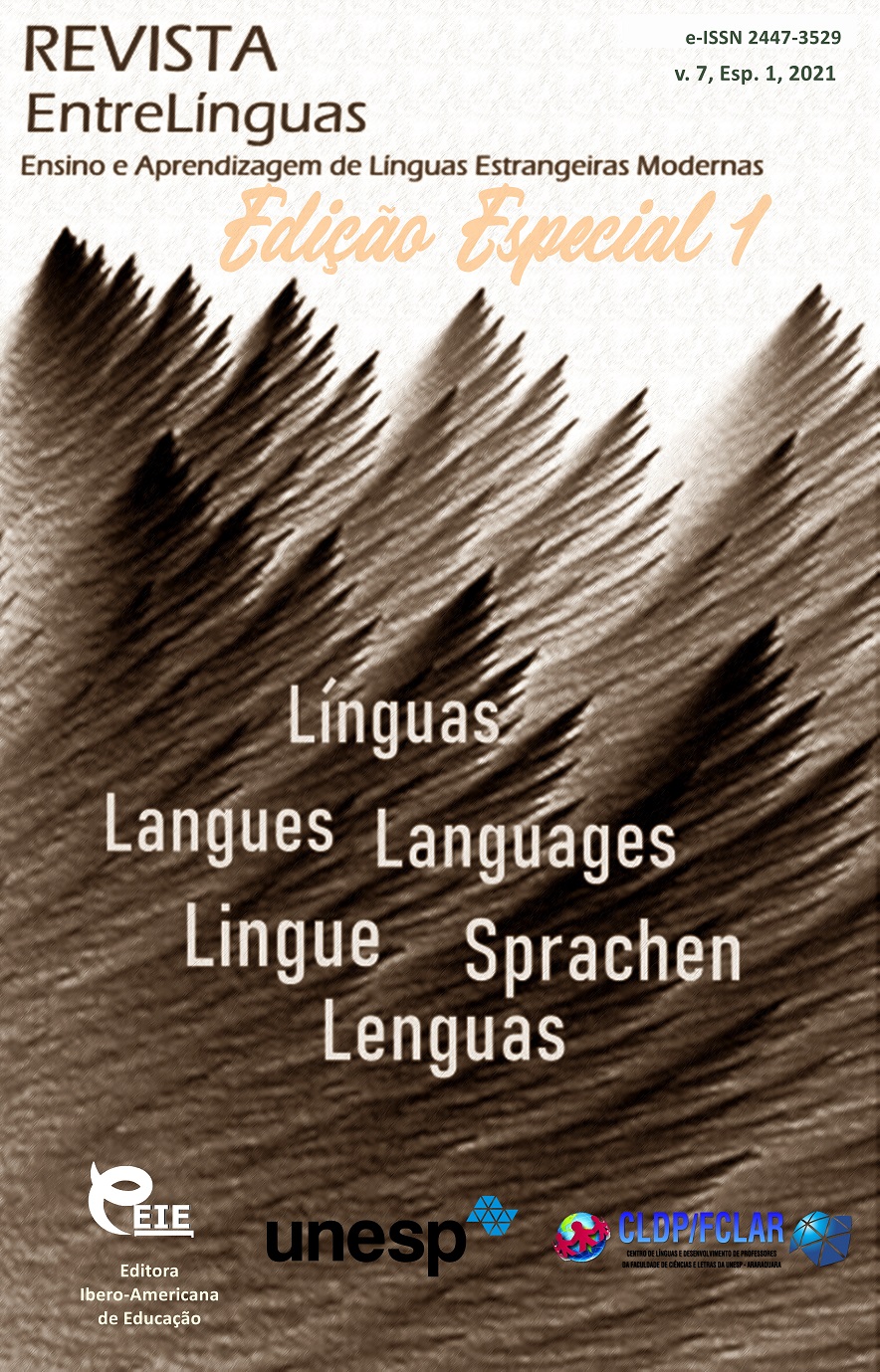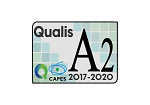Polycode: creolized text as manipulation means
DOI:
https://doi.org/10.29051/el.v7iEsp1.14892Keywords:
Multicode, Creolized text, Manipulation, Transforming tactics, Supporting tactics, Distracting tacticsAbstract
One way of influencing is to creolize a text. In the current study, it was discussed the manipulative potential of creolized texts. Adding an illustration to a verbal text allows the reader to visualize information and create a planned impact on the recipient other than the impact of a verbal text, i.e., the content of the verbal text is modified. Three groups of tactics were identified during the study: 1) supporting tactics (the content of the text receives support from the illustration); 2) transforming tactics (text content transformation); 3) distracting tactics (distraction of the addressee from the verbal text content). Using the tactics of the first group, one can "say" the same thing via an illustration; using the tactics of the second group; one can add ideas, change the content of the verbal text, and using the tactics of the third group, one can distract the recipients from the verbal text content.
Downloads
References
ACHWAN, R.; GANIE-ROCHMAN, M.; ALAMSYAH, A. R.; TRIANA, L. University reform and the development of social sciences in Indonesia. International Journal of Educational Development, v. 7, n. 8, p. 102269, 2020.
AIMOLDINA, A.; ZHARKYNBEKOVA, S. Incorporating authentic models into business letter writing within the ESP course at Kazakhstani universities. Hacettepe University Journal of Education, v. 29, n. 29-2, p. 16-33, 2014.
ANISIMOVA, E. E. Linguistics and intercultural communication (based on creolized texts): Textbook for the students of foreign languages universities. Moscow/ Russia: Publishing Center Academy. (2003).
BENDER, E. M.; LASCARIDES, A. Linguistic fundamentals for natural language processing ii: 100 essentials from semantics and pragmatics. Synthesis Lectures on Human Language Technologies,v. 12, n. 3, p. 1-268, p. 2019.
CHERNJAVSKAJA, V. Linguistics of the text. polycode, intertextuality, interdiscursiveness. Institute of Linguistics RAS, v. 1, n. 2, p. 5-21, 2009.
FARZADNIA, S.; GILES, H. Patient-provider interaction: A communication accommodation theory perspective. International Journal of Society, Culture & Language, v. 3, n. 2, p. 17-34, 2015.
KEATON, S. A.; GILES, H. Subjective health: The roles of communication, language, aging, stereotypes, and culture. International Journal of Society, Culture & Language, v. 4, n. 2, p. 1-10, 2016.
LEEWEN, E. Sternes “Journal to Eliza”: A semiological and linguistic approach to the text. Tübingen/ Germany: Gunter Narr Verlag, 1981.
LIANG, M. Y. Achieving multimodal cohesion during intercultural conversations. International Journal of Society, Culture & Language, v. 4, n. 2, p. 55-70, 2016.
MARDIEVA, L. Pre-existing visual images and phenomena: A linguistic approach. SGEM, v. 1, n. 3, p. 765-772, 2016.
MERZLYAKOV, D.; IGNATOVA, E. Understanding creolized text in the system “author-reader” on the example of texts with graphic and realistic images. In: INTERNATIONAL CONFERENCE ON PEDAGOGY, COMMUNICATION AND SOCIOLOGY, 2019, Ningbo. Proceedings […]. Ningbo, China: ICPCS, 2019.
MOUSAVI, S. A.; FARAHANI, A. A.; ARIZAVI, S. An investigation of the linguistic, paralinguistic and sociocultural effects of input on the perception and translation of gerunds by Persian speakers of English. International Journal of Society, Culture & Language, v. 2, n. 1, p. 119-130, 2014.
MUKHAMETZYANOVA, L.; MARDIEVA, L. The polyfunctuanality in the names of newspapers and magazines. Revista San Gregorio, v. 20, n. 1, p. 148-153, 2017.
NASYROVA, A.; KHABUTDINOV, A.; KHABUTDINOVA, M. Magazine illustration as epoch investigation source (Aisilu (1959) by BaqiUrmanche as an example). Turkish online journal of design art and communication, v. 2, n. 6, p. 3094-3099, 2016.
NOVIKOV, A. I. Semantics of the text and its formalization. Moscow/ Russia: Nauka Publisher, 1983.
RIEDEL, I. Colors in religion, society, art and psychotherapy. Stuttgart/ Germany: Kreuz Publisher, 1999.
RYABOVA, M. Foreign language as a factor of personality development: methodology for the development of a socio-philosophical concept, Saransk/ Russia: Mordovia University Publishing Houses, 2007.
SHKURKO, V.; MARDIEVA, L.; SHCHUKLINA, T.; CHUDINOV, A. Poster images in a new linguistic and extralinguistic context. Amazonia Investigation, v. 7, n. 12, p. 320-324, 2018.
SONIN, A. Understanding polycode texts: the cognitive aspect. Institute of Linguistics RAS, v. 5, n. 2, p. 9-19, 2005.
ULANOVSKY, A. False metaphors of happiness. Institute of Linguistics RAS, v. 13, n. 4, p. 10-19, 2019.
VASHUNINA, I. V.; RYABOVA, M. E.; EGOROVA, L. A. Polycode hypertext in polylingual discourse of intercultural communications. Xlinguae, v. 7, n. 4, p. 25-36, 2018.
VERBOON, P.; VAN DIJKE, M. The effect of perceived deterrence on compliance with authorities: the moderating influence of procedural justice. International Journal of Criminology and Sociology, v. 1, n. 5, p. 151-161, 2012.
VOISHVILLO, E. K. The concept as a form of thinking: logical and epistemological analysis. Moscow/ Russia: Moscow State University, 1989.
WILDGEN, W.; SEMIOTIK, V. The development of the visible: from the cave picture to the modern city. Bielefeld/ Germany: Transcript-Verlag, 2013.
Downloads
Published
How to Cite
Issue
Section
License

This work is licensed under a Creative Commons Attribution-NonCommercial-ShareAlike 4.0 International License.
Os manuscritos aceitos e publicados são de propriedade da Revista EntreLínguas. Os artigos publicados e as referências citadas na Revista EntreLínguas são de inteira responsabilidade de seus autores.
Transferência de direitos autorais – autorização para publicação
Caso o artigo submetido seja aprovado para publicação, já fica acordado que o(s) autor(es) autoriza(m) a UNESP a reproduzi-lo e publicá-lo na EntreLínguas, entendendo-se os termos “reprodução” e “publicação” conforme definição respectivamente dos incisos VI e I do artigo 5° da Lei 9610/98. O artigo poderá ser acessado pela rede mundial de computadores (Internet), sendo permitidas, a título gratuito, a consulta e a reprodução de exemplar do artigo para uso próprio de quem a consulta, desde que haja a citação ao texto consultado. Essa autorização de publicação 328 EntreLínguas, Araraquara, v. 1, n .2, p. 323-328, jul./dez. 2015 não tem limitação de tempo, ficando a UNESP responsável pela manutenção da identificação do(s) autor(es) do artigo. Os artigos publicados e as referências citadas na Revista EntreLínguas são de inteira responsabilidade de seus autores.











